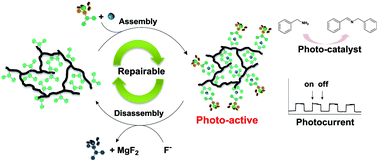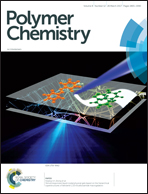Repairable photoactive polymer systems via metal–terpyridine-based self-assembly†
Abstract
The development of sustainable polymeric photo-catalytic systems for the conversion of solar energy is an important issue. In this perspective, efficient photo-catalytic systems have been developed by many research groups; however, their long-term stability or sustainability is still challenging and need to be resolved. In order to realize sustainable polymeric photoactive systems, we developed terpyridine (tpy)-based polymers and their ruthenium complexes, which were reversibly assembled and disassembled through metal ion–ligand interactions. In the presence of metal ions, Ru-based photoactive polymers were assembled on tpy-coated ITO substrates, generating visible-light induced photocurrents. Subsequently, when disassembled by the introduction of tetra-n-butylammonium fluoride, the assembled polymeric complex decomposed, decreasing the photocurrent. However, the photocurrent efficiency of this system was recovered through re-assembly and repeated several times without a significant decrease in its efficiency. In addition, a sustainable photo-catalyst system was achieved by photo-oxidative coupling with benzylamine. The initial active photo-catalytic system became inactive after disassembly; however, its activity was restored through assembly again, and this process was repeated successfully several times. The self-assembly via reversible metal ion–ligand interaction would enable photo-catalytic systems to be self-repairable and sustainable.



 Please wait while we load your content...
Please wait while we load your content...